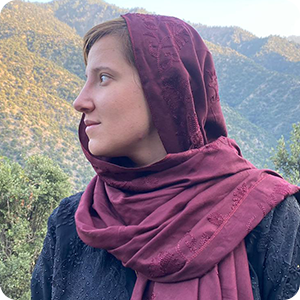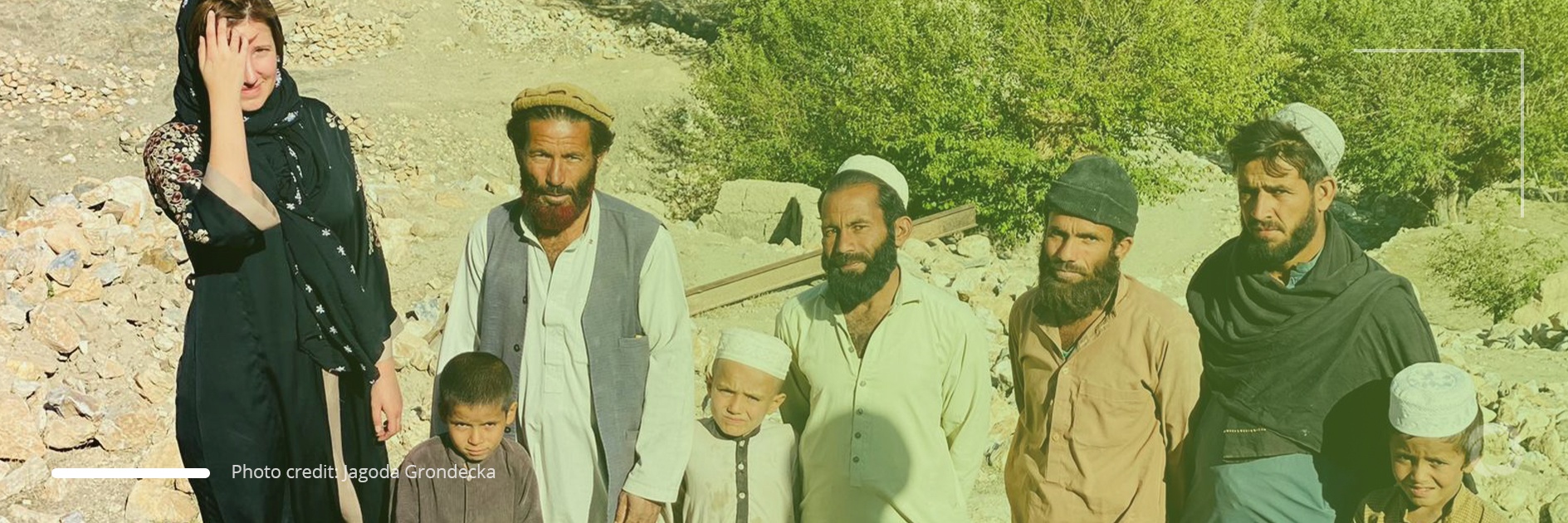With deeply rooted traditions of early marriages, a weak social assistance system, and brutal domestic violence, Afghanistan was considered to be the worst place to be a woman even before the Taliban takeover in August 2021. However, the regime has re-introduced many measures banning the few existing activities and opportunities of the country’s 19 million women. Anticipating the upcoming changes, many women involved in social, economic, and political spheres – a right won so hard over the past two decades – have either left the country or are waiting for a chance to flee. Those who have remained in Afghanistan have to double their efforts in the struggle with poverty and unemployment amongst other issues.
DevelopmentAid reporter, Joanna Kędzierska, spoke with Jagoda Grondecka, a Polish journalist based in Kabul, about the changes that Afghani women have had to bear.
 JK: How much have the conditions of life changed for women since the Taliban took over power in August 2021?
JK: How much have the conditions of life changed for women since the Taliban took over power in August 2021?
 JG: First of all, I would like to emphasize that those changes that we saw during the past 20 years weren’t experienced by all women, but rather those living in Kabul and other big cities such as Herat, Mazar-i-Sharif, or Kandahar whereas 70% of Afghanis live in the provinces and are poorly educated. There is a very high rate of illiteracy, especially amongst women. The situation of women living there hasn’t changed that much. Nonetheless, a Human Rights Watch survey indicated that more people from rural areas have been willing to send their daughters to school since the West military intervention in 2001 than before.
JG: First of all, I would like to emphasize that those changes that we saw during the past 20 years weren’t experienced by all women, but rather those living in Kabul and other big cities such as Herat, Mazar-i-Sharif, or Kandahar whereas 70% of Afghanis live in the provinces and are poorly educated. There is a very high rate of illiteracy, especially amongst women. The situation of women living there hasn’t changed that much. Nonetheless, a Human Rights Watch survey indicated that more people from rural areas have been willing to send their daughters to school since the West military intervention in 2001 than before.
As for those who remained – the Taliban government sent them home until its decision is made. The Taliban announced that women will not be allowed to occupy high-level positions, such as ministers or deputies, as under the previous government. Only those who were not replaceable by men were allowed to go back to work, such as health sector employees. Some women doctors and nurses told me that nothing had changed for them but others admitted that they are not allowed to take care of male patients or work night shifts. For instance, at night women in the gynecology and obstetrics wards are left alone because the only ones who are allowed to assist them – the female doctors – cannot stay overnight in the hospital. Other women who used to work as teachers, office employees, and bank clerks were ordered to stay at home although nobody told them that this was the final decision. Instead, it was announced that “proper work conditions” must be provided for them first according to “cultural and religious values” so that they have no contact with men. Still, nobody knows when and whether such conditions will be provided. Women rather don’t believe they will be able to go back to work.
 JK: Did the women who lost their jobs lose their income as well?
JK: Did the women who lost their jobs lose their income as well?
 JG: Yes, and the most affected are the women who were the sole job holders in the family. Their income was crucial especially in a country that is as much impacted by poverty as Afghanistan is.
JG: Yes, and the most affected are the women who were the sole job holders in the family. Their income was crucial especially in a country that is as much impacted by poverty as Afghanistan is.
 JK: In Afghanistan, are women more affected by poverty than men?
JK: In Afghanistan, are women more affected by poverty than men?
 JG: The most affected are the children in rural areas. I had an opportunity to visit hospitals in Kabul provinces and they are full of malnourished children as women don’t have breast milk to feed them and they cannot afford to buy modified milk. But I also saw older children suffering due to food insecurity. People outside Kabul very often cannot afford to buy a couple of loaves of bread. But it’s true that women suffer more in conflicts compared to men. The media has recently reported a growing number of young girls being sold to older men. This practice is deeply rooted in Afghan culture and it has always existed but recently it has surged. When a family has 10 children, it is obvious that once a chance to lose some of the burden appears, in exchange for so desperately needed money, girls will be sold by marrying them off. And marriage at such a young age means that those girls lose any education opportunities. I also heard many stories of women who were educated but had lost their income, and they had to hide from their family members as they tried to push them into arranged marriages which would guarantee them money for living. Their situation is very hard as they cannot work.
JG: The most affected are the children in rural areas. I had an opportunity to visit hospitals in Kabul provinces and they are full of malnourished children as women don’t have breast milk to feed them and they cannot afford to buy modified milk. But I also saw older children suffering due to food insecurity. People outside Kabul very often cannot afford to buy a couple of loaves of bread. But it’s true that women suffer more in conflicts compared to men. The media has recently reported a growing number of young girls being sold to older men. This practice is deeply rooted in Afghan culture and it has always existed but recently it has surged. When a family has 10 children, it is obvious that once a chance to lose some of the burden appears, in exchange for so desperately needed money, girls will be sold by marrying them off. And marriage at such a young age means that those girls lose any education opportunities. I also heard many stories of women who were educated but had lost their income, and they had to hide from their family members as they tried to push them into arranged marriages which would guarantee them money for living. Their situation is very hard as they cannot work.
 JK: And what about education? We have learned from media reports that the Taliban has also placed many obstacles, limiting the access of women and girls to the education system.
JK: And what about education? We have learned from media reports that the Taliban has also placed many obstacles, limiting the access of women and girls to the education system.
 JG: The changes were visible right after the Taliban took over power as this overlapped with the time when children go back to school after the summer holidays. It turned out that in primary and middle schools that had 12 classes, the girls could only go back to the primary classes from 1st to 6th grade while the boys could attend classes from 1st to 12th grade meaning they could finish middle school. The Taliban government explained that it would change this decision when “proper conditions were provided,” similar to the case of some jobs that women can no longer occupy.
JG: The changes were visible right after the Taliban took over power as this overlapped with the time when children go back to school after the summer holidays. It turned out that in primary and middle schools that had 12 classes, the girls could only go back to the primary classes from 1st to 6th grade while the boys could attend classes from 1st to 12th grade meaning they could finish middle school. The Taliban government explained that it would change this decision when “proper conditions were provided,” similar to the case of some jobs that women can no longer occupy.
The Taliban decided to re-open some schools in rural areas for girls but not all of them and a few were opened and closed after a while. I know that some secret online classes are being organized for girls, but this is rather marginal as not many have internet access and devices to access such classes. At universities, women students can also only be taught by female lecturers. Thus, this is another method of depriving young women of higher education as there aren’t enough female lecturers. There were always fewer female than male lecturers and many of female professors have recently left the country. So, this is another way of limiting access to higher education for young women.
 JK: Since the Taliban has prohibited many women’s employment, have they offered anything instead?
JK: Since the Taliban has prohibited many women’s employment, have they offered anything instead?
 JG: No. The Taliban is not able to offer anything to anyone. The Taliban cannot even afford to pay their own militants as the financial resources of the Afghan Central Bank have been frozen by the US. There is also a problem in delivering humanitarian assistance, avoiding the Taliban, and reaching people who are in real need. The Taliban don’t pay doctors, nurses, officials, or teachers because they don’t have the money.
JG: No. The Taliban is not able to offer anything to anyone. The Taliban cannot even afford to pay their own militants as the financial resources of the Afghan Central Bank have been frozen by the US. There is also a problem in delivering humanitarian assistance, avoiding the Taliban, and reaching people who are in real need. The Taliban don’t pay doctors, nurses, officials, or teachers because they don’t have the money.
 JK: Can you describe the situation of humanitarian assistance and NGO activity? Are there any organizations that currently address women’s needs?
JK: Can you describe the situation of humanitarian assistance and NGO activity? Are there any organizations that currently address women’s needs?
 JG: Non-governmental organizations working in Afghanistan have a problem because women working there, both foreigners and Afghanis, are not allowed to go out without husbands. For many, this is an obstacle that is impossible to overcome. Without women working on the ground, in turn, it is not possible to reach women beneficiaries in need as women don’t want to talk about their problems with men. Still, there are NGOs trying to provide assistance but their work is very hard, especially because the Taliban are reluctant to allow any help if this help doesn’t go through their filters. The most active women who fought for women’s rights had to leave the country once the Taliban took over Kabul and thus many vulnerable women have been deprived of support.
JG: Non-governmental organizations working in Afghanistan have a problem because women working there, both foreigners and Afghanis, are not allowed to go out without husbands. For many, this is an obstacle that is impossible to overcome. Without women working on the ground, in turn, it is not possible to reach women beneficiaries in need as women don’t want to talk about their problems with men. Still, there are NGOs trying to provide assistance but their work is very hard, especially because the Taliban are reluctant to allow any help if this help doesn’t go through their filters. The most active women who fought for women’s rights had to leave the country once the Taliban took over Kabul and thus many vulnerable women have been deprived of support.

